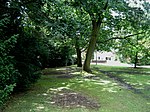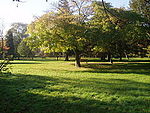Thames Ditton Island
Borough of ElmbridgeEngvarB from July 2016Islands of the River Thames

Three river islands (aits) form a linear group, close to the junction of the two main old streets of Thames Ditton village, in the River Thames in a corner of modern Surrey, on the Kingston reach above Teddington Lock. Thames Ditton Island, the dominant ait, is 350 yards (320 m) long and has 48 houses with gardens (and moorings); Boyle Farm Island has one house; Swan Island, between the two, is the smallest.
Excerpt from the Wikipedia article Thames Ditton Island (License: CC BY-SA 3.0, Authors, Images).Thames Ditton Island
Barge Walk, London
Geographical coordinates (GPS) Address Nearby Places Show on map
Geographical coordinates (GPS)
| Latitude | Longitude |
|---|---|
| N 51.394444444444 ° | E -0.33194444444444 ° |
Address
Barge Walk
Barge Walk
KT6 5QD London (London Borough of Richmond upon Thames)
England, United Kingdom
Open on Google Maps










